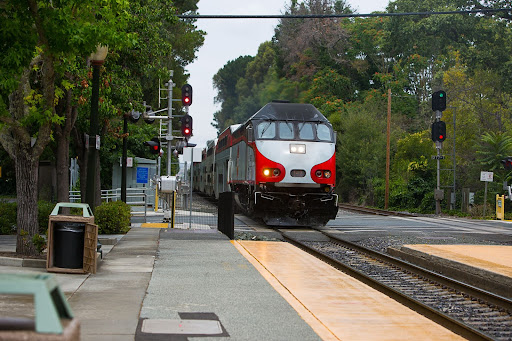In highly populated areas near railroad crossings, train horns can blare dozens of times a day at up to 110 decibels, disrupting the lives of current residents and making new development near railroads less attractive.
The path to quiet zones
When passing through at-grade railroad crossings, trains are required by law to blare their horn in order to alert any possible unknowing pedestrians or vehicles of their approach.They do so at a volume of up to 110 decibels, which is equivalent to attending a rock concert or operating a gas lawn mower.
A growing number of Bay Area cities have been pursuing “quiet zones” that are sections of a rail line that add safety improvements and allow trains to pass through with out regularly blowing the locomotive horn. The process for setting up a quiet zone is established by the Federal Railroad Administration. With a quiet zone, trains can still blow their horns in emergency situations, or during maintenance or testing.
In 2016, the Town of Atherton implemented a quiet zone at its Fair Oaks Lane at-grade crossing, after installing a four-quadrant gate that fully block cars from entering the crossing in the event of an approaching train. Trains in Atherton are still required to blow their horns at the Watkins crossing, since that crossing has only a two-quadrant gate.
Since then, other Bay Area Cities have advanced quiet zones as well.
Emeryville held a groundbreaking for its “quiet zone” project on June 14, 2022. Emeryville had been exploring a quiet zone for the 65th, 66th, and 67th street railroad crossings since 2008. Using city funding as well as funding from California’s gas tax-funded Trade Corridor Enhancement Program, the Alameda County Transportation Commission’s Measure BB, and the Alameda County Congestion Management Agency Transportation Improvement Program, the project is slated to cost $8.87 million by the completion of construction in early 2024. These funds will be used for necessary improvements to the 65th and 67th street crossings, as well as turning the 66th street crossing into a cul-de-sac, which will allow for the creation of this “quiet zone”.S
In San Jose, a partial quiet zone went into effect on May 10, 2022. In 2018, Union Pacific changed its operating structure, increasing the number of trains passing through the Warm Springs Corridor and shocking the local community. Councilmember Raul Peralez, representing this downtown district, requested a “quiet zone” be established in March 2019, and with the support and outcry of the public, the project was approved. The transportation department hired a consultant to study if the corridor was fit for a “quiet zone”, and with $12.8 million in funding from the city budget as well as SB129, the proper safety measures were put in place and the “partial quiet zone” went into effect on May 10, 2022.
In the long run, grade separation – removing the at-grade crossing by separating the railroad tracks from the street – is a more robust solution. But these projects are expensive and can take many years. In the mean time, quiet zones can give neighbors more peace and quiet.

